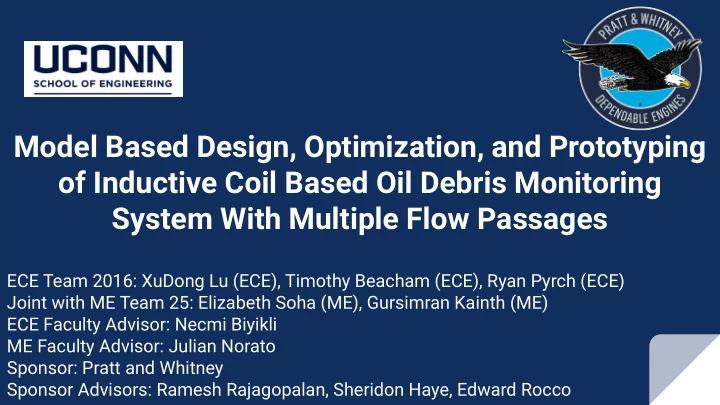

Model Based Design, Optimization, and Prototyping of Inductive Coil Based Oil Debris Monitoring System With Multiple Flow Passages ECE Team 2016: XuDong Lu (ECE), Timothy Beacham (ECE), Ryan Pyrch (ECE) Joint with ME Team 25: Elizabeth Soha (ME), Gursimran Kainth (ME) ECE Faculty Advisor: Necmi Biyikli ME Faculty Advisor: Julian Norato Sponsor: Pratt and Whitney Sponsor Advisors: Ramesh Rajagopalan, Sheridon Haye, Edward Rocco
Project Overview ● Design a Dual-Bore Oil Debris Monitoring (ODM) System Used in both commercial and military ○ airplanes ○ Detects ferrous and non-ferrous material within turbine Monitors wear and tear ○ Provides an alert/warning of failure of ● mechanical components ○ Gears, bearings, pumps, & etc.
Problems with Current Single-Bore Design ● Unable to detect smaller debris When Bore size is increased ○ ■ Pressure decreases ■ Size of particle detection decreases ○ When Bore size is decreased Pressure increases ■ Size of particle detection increases ■
Requirements & Specifications ● ODM sensors in parallel Study magnetic field interactions ● ○ Characteristics of dual bore ○ Sizing, and configuration Design and build the Dual-Bore ODM system ● ○ Ability for particle detection ○ Optimize the design of a multi-bore ODM System Configuration Advanced indication of Component failure ○ Build, Test and Analyze physical model ●
Constraints Issues with interaction between magnetic fields ● How we combat the interaction: ○ ■ Changing distance between ODM systems ■ One coil wound to the right the other to the left Magnetic Shield in between the ODM ■ systems ● Operation under extreme conditions ● Pressure in oil passageway ○ Large diameter required
Approach ● Build multiple magnetic field assemblies and configurations Use of PVC Piping as flow passage ○ Use of different sizes copper wiring for the coils ○ ○ Validate models ○ Optimal configuration ● Determine optimal coil placement to minimize or leverage interference
Design Ideas ● Using Hall Effect Sensor ● Using Sensing Coil
Solution Sensing Coil: Hall Effect Sensor: Physical Model Setup Location is permanent Precise location of sensor ● ● and allows accurate required to obtain good results reading ● Ease of ability to replicate ● Inaccurate results Difficulty telling the ● ● Easily able to determine difference between just Inductive Coil the difference between the inductive coil and the Sensing Coil just the inductive coil and inductive coil with the inductive coil with particles Inductive Coil particles ● More expensive Less expensive ●
Single Bore Preliminary Results ● Sensing Coil Detecting Inductive Coils ● Particle Detection Analysis
Dual Bore Preliminary Results
Dual Bore Preliminary Results (cont.)
Fall Timeline
Spring Timeline
Responsibilities
Budget
Next Steps Single Bore: Dual Bore: ● Optimizing detection strength of ● Limiting interference between the sensing coil by altering each bore various variables Using Dual Bore to detect a ● ○ Wire Gauge particle passing through the coil ○ Number of Turns setup Inside Diameter Optimizing spacing and strength ○ ● Input Voltage of each coil setup ○ ○ Input Frequency
References [1] D. Muir and B. Howe, “In-Line Oil Debris Monitor (ODM) for the Advanced Technical Fighter Engine” in Technology Showcase: Integrated Monitoring, Diagnostics and Failure Prevention, Mobile, Alabama, 1996. [2] J. P . Davis, “Electronic Interface for an Inductive Wear Debris Sensor for Detection of Ferrous and Non-Ferrous Particles”, M.S. thesis, College of Eng., Univ. Akron, Akron, OH, 2013.
Questions?
Recommend
More recommend